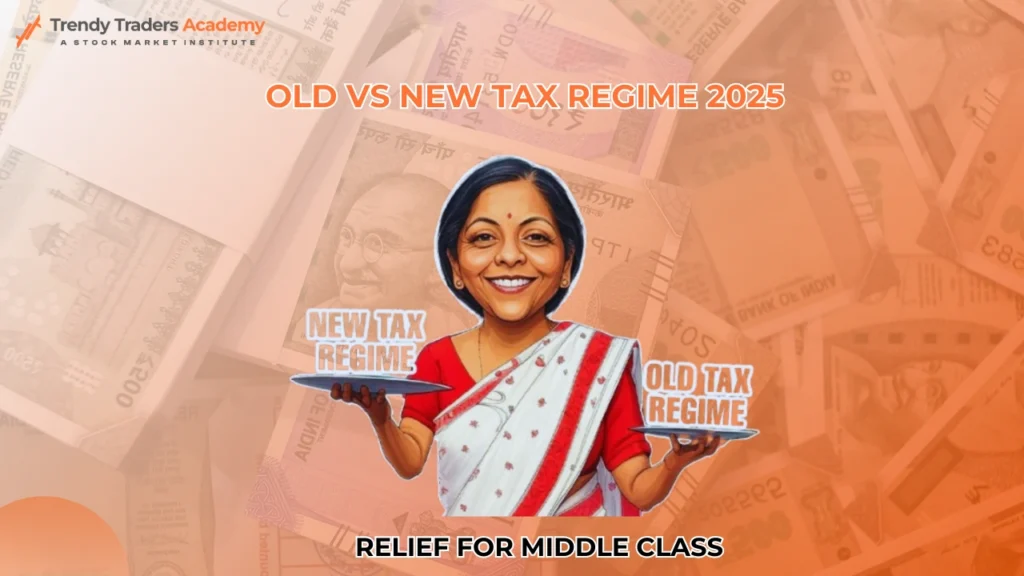
Old vs New Tax Regime: Relief for middle class
Understanding the Old and New Tax Regimes in India
This is particularly complex when one is trying to differentiate between the old tax system or the new one Also known as tax regime. The taxpayers are allowed to decide between these two regimes in India although both have some benefits and limitations. This article will give the reader a brief understanding of both, which will guide the reader in making the right decision with regards to his financial status. We will also understand new tax regime deductions and exemptions.
What is the Old Tax Regime ?
The Old Tax Regime is the prior way through which the taxes have been computed in India for a number of years. It has several main exemptions and deductions whereby certain amounts can be deducted from one’s gross income in order to arrive at the taxable total income. As per this regime, many exemptions are allowed by the government like HRA exemption, LTA exemption, medical exemptions and many more exemptions under section 80C of the income tax.
Key Features of the Old Tax Regime :
The Old Tax Regime is famous for so many exemptions and deductions that are available in it. Investment made under certain activities or products such as Public Provident Fund, National Savings Certificates, premium amount of life insurance policy, etc can be claimed for deductions in Section 80C.
House Rent Allowance (HRA):This is one of the biggest exempted allowances in the Old tax regime which enables taxpayers to practice deductions on rent paid.
Leave Travel Allowance (LTA): similar to the earlier one, the LTA provision allows the taxpayers to claim the Expenses on personal tours.
Medical Reimbursements: Another allowable allowance under the Old Tax Regime is medical expenses.
Apart from the other specified deductions, the Old Tax Regime shall allow a deduction of ₹50,000 from the total income as a standard deduction.
Section 80D Deductions: This allows a prior to tax benefits for expenses paid on health insurance premium of the taxpayer as well as dependent family members.
Interest on Home Loan (Section 24): Existing under section 80EE, taxpayers can claim a deduction of up to ₹2 lakh on the interest paid during the year on home loans taken for the purchase of the residential house.
Education Loan (Section 80E): The interest payment for an education loan is also allowed under the Old Tax Regime.
What is the New Tax Regime ?
The New Tax Regime was introduced during the Union Budget 2020 and it is another way of computation of taxes. The New Tax Regime is one that offers lower tax rates than the Old Tax Regime but new tax regime deductions and exemptions are less. The main objective of this kind of regime is the attempt to ease the taxation process and to offer taxpayers this enjoyable approach.
Key Features of the New Tax Regime :
Lower Tax Rates: The new income tax regime is a package with lesser rates of tax on the income earned from job and other sources.
New tax regime deductions & Exemptions: Another important feature of the New Tax Regime is that there is no provision of any exemption and deduction. While availing this option, the taxpayer is rejected to claim benefits of house rent allowance, leave travel allowance, and section 80C deductions.
New Tax Regime Slabs : The New Tax Regime entails new income tax slabs with varying rates, which is intended to bring out an easy procedure to calculate taxes.
Simplified Compliance: Thus, the New Tax Regime has made compliance very easy as the taxpayers are not required to maintain and claim various exemptions and deductions.
Introduction of New Tax Regime is optional which means that a taxpayer has an option to switch to a new income tax regime any time or he can continue to stick to the Old Tax Regime that exists.
Comparing the Old Tax Regime and the New Tax Regime :
To better understand the differences between the two regimes, let’s break down the key aspects and how they impact taxpayers.
Income Tax Slabs:
In the previous system, the income tax rates were higher as compared to the new one, but there were certain provisions of exemption for certain incomes and deductions for several expenditures. The new income tax regime has comparatively lower tax rates, but no deductions or exemptions are allowed for the taxpayers.Exemptions in the New Tax Regime:
In the structure of the Old Tax Regime the Taxpayers could take many exemptions such as House Rent Allowance (HRA), Leave Travel Allowance (LTA), Medical reimbursements etc. This new Tax Regime, therefore, does not have any form of exception and therefore whoever is a taxpayer should take their time into consideration.New Income Tax Regime Deductions:
The Old Tax Regime permits Tax Saving under section 80C, 80D and 80E of the Income Tax Act. This can cause considerable reduction of taxable incomes of an individual as shown below. However, as per the provisions of the new format of tax laws New Tax Regime, it is mandatory not to allow any of the above deductions and every individual has to pay taxes as per his or her income.Simplicity and Compliance:
New Tax System also intends to make the tax filing less cumbersome for the citizens. Due to this the taxpayers do not need to follow many exemptions and deductions which sometimes complicate the filing of returns. The Old Tax Regime gives more benefits to the company but still is complicated when it comes to record keeping and analysis of the laws most especially to reap the benefits for the company.Impact on Different Income Groups:
That is why, the preferences concerning the Old Tax Regime and the New Tax Regime can be rather different relative to different income groups. Those people who pay higher taxes since they get to enjoy several exemptions and deductions in the preceding tax system may opt to remain under the Old Tax Regime. However, those lower to middle-income earners with comparatively lesser number of exemptions and deductions would be more benefited by the new income tax regime because of its relatively parasite rates.Flexibility for Tax Planning:
The Old Tax Regime offers more flexibility for tax planning, allowing taxpayers to strategically invest in tax-saving instruments to reduce their taxable income. The new income tax regime , while simpler, does not offer the same level of flexibility, as it does not include exemptions or deductions.
Old Tax Regime Vs New Tax Regime
Feature | Old Tax Regime | New Tax Regime |
Income Tax Slabs | Higher tax rates with multiple slabs | Lower tax rates with revised slabs |
Exemptions | Multiple exemptions available (HRA, LTA, etc.) | No exemptions allowed |
Deductions | Various deductions under Section 80C, 80D, etc. | No deductions available |
Flexibility for Tax Planning | High, allows strategic investments in tax-saving instruments | Low, no investment-based tax planning |
Simplicity of Filing | Complex due to multiple exemptions and deductions | Simple, straightforward with no exemptions or deductions |
Tax Rate (Up to ₹2.5 lakh) | Nil | Nil |
Tax Rate (₹2.5 lakh – ₹5 lakh) | 5% | 5% |
Tax Rate (₹5 lakh – ₹7.5 lakh) | 20% | 10% |
Tax Rate (₹7.5 lakh – ₹10 lakh) | 20% | 15% |
Tax Rate (₹10 lakh – ₹12.5 lakh) | 30% | 20% |
Tax Rate (₹12.5 lakh – ₹15 lakh) | 30% | 25% |
Tax Rate (Above ₹15 lakh) | 30% | 30% |
Who Should Choose | Those with significant investments and eligible for multiple exemptions | Those preferring simplicity and without significant investments |
Compliance Requirements | Higher, due to detailed record-keeping | Lower, due to reduced complexity |
In this table we will see all the differences and updates between New Tax regime and old one like New tax regime slabs , New income tax regime, exemptions in New tax regime and New tax regime deductions
Who Should Choose the Old Tax Regime ?
In view of this, the Old Tax Regime is favorable to the taxpayers who;
Always should have some tax-saving instruments in the list of investible products like PPF, NSC and insurance policies.
It shall be important to note that they qualify for exemptions of HRA and LTA.
Thus, they incur medical expenses that meet the requirement for deductions.
Rather opt for many exclusions and deductions so that they can have a reduced taxable income.
It is an advantage if one is comfortable with the tax planning and record keeping sorts.
Who Should Choose the New Tax Regime ?
New Tax System is appropriate for the taxpayers who:
It must not have large positions in tax efficient instruments.
Thus, citizens prefer a simpler and less intricate method of computation of taxes.
Does not wish to have records of many exemptions and deductions.
Are in the lower income tax bands under which the new slabs of taxation provide better and suitable rates.
Choose for less hassle and a quicker approach of filing the taxes.
Making an Informed Decision :
As stated above, the selection of the Old Tax Regime or the New Tax Regime depends on the circumstances and preference of the person. Here, therefore, are some guidelines, which will assist you to arrive at the right decision:
Check Your Income: Frequent your annual income and then see to which tax slab you fall in both the regimes.
Claim Exemptions and Deductions: Ensure that you prepare a list of the exemptions and deductions you are allowed under the Old Tax Regime. Identify and list the benefits that can be obtained from such changes and quantify how much each of them will cost to be implemented.
Evaluate Tax Burden: When comparing the new tax regime to the current tax structure, one should deduce the amount of tax payable on income under the two regimes using the new income tax regime slabs and the exemptions of the new tax regimes.
Refer to Personal Goals: It is important to reflect on long-term financial goals and how the regime will help achieve them. For instance, if you have plans to put a concentrated expenditure on the purchase of tax-saving investments tools, it may be better for you to be under the Old Tax Regime.
Add Professional Consultation: It may be good to employ the services of a tax professional given that they will be willing to offer professional advice that may fit your current reputation.
Scenario Analysis: Create hypothetical scenarios to compare the tax payable under both regimes. Comparing different levels of income, investments, and expenses allows to determine which of the regimes will bring more benefits in terms of tax savings.
Exploring changes to Lifestyle: Discuss any and every lifestyle adjustments or financial targets that may affect the tax planning from your end. For example, if, for instance, you have plans of acquiring a home or funding your tuition fees in higher learning institution, then the Old Tax Regime possesses certain advantages.
Conclusion
Coming to the New Tax Regime, the Act has provided two options for tax computation to the taxpayers in India. The facility of huge exemption and deductions of the earlier Tax Regime has still attracted a number of individuals who want to concentrate on tax advantages. On the same note, there is the New Tax Regime that involves less distortion and evasion since it does not provide for exemptions but lower rates of taxation.
Altogether, the latter completely depends on an individual’s financial capacity, personal priorities and plans for the future. It is therefore possible for the taxpayers to differentiate between the features of the two regimes and make a proper decision that is best suited for their situation.
FAQ'S
The New Tax Regime, introduced in Budget 2020 and revised in Budget 2025, offers lower tax rates but limits most exemptions and deductions available under the old regime. It’s designed to simplify the tax structure.
The updated tax slabs are:
- Up to ₹3,00,000 – Nil
- ₹3,00,001 to ₹7,00,000 – 5%
- ₹7,00,001 to ₹10,00,000 – 10%
- ₹10,00,001 to ₹12,00,000 – 15%
- ₹12,00,001 to ₹15,00,000 – 20%
- Above ₹15,00,000 – 30%
Individuals earning up to ₹12,00,000 can effectively pay zero tax due to deductions like the standard deduction and NPS contributions.
For salaried individuals, the standard deduction has been increased to ₹75,000 under the new regime.
No, common exemptions such as House Rent Allowance (HRA), Leave Travel Allowance (LTA), and others are not available under the new tax regime.
While most deductions are removed, the following are still available:
- Standard Deduction of ₹75,000
- Employer’s contribution to NPS (Section 80CCD(2))
- Agniveer Corpus Fund Deduction (Section 80CCH)
- Deduction under Section 80JJAA for new employment
No, it is optional. Taxpayers can choose between the old and new regimes based on their financial situation.











